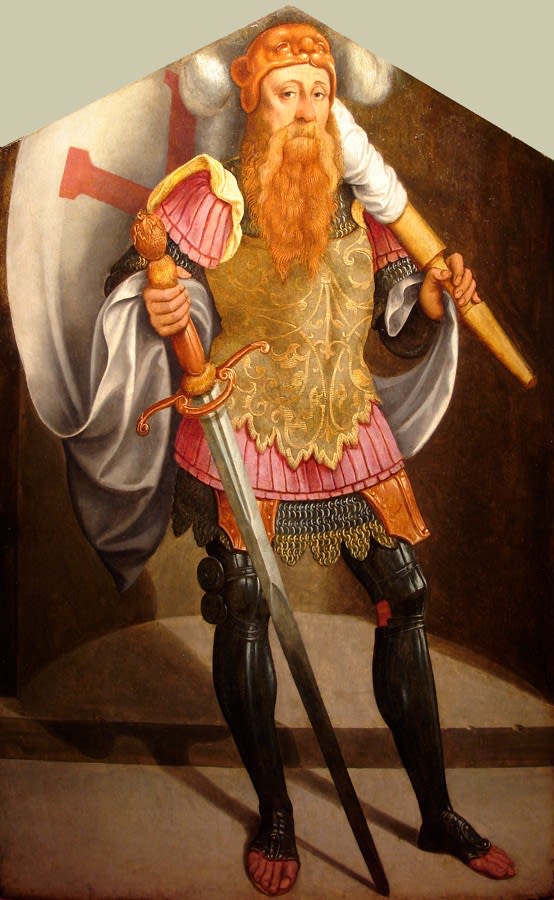
German School
To view all current artworks for sale visit philipmould.com
This portrait has been recently identified as Godfrey de Bouillon, the effective leader of the first Crusade. The portrait was once thought to show Emperor Frederick I of Germany, and had been altered to form a large rectangular panel. However, restoration and cleaning has revealed a triangular-shaped panel, and a red crusader’s cross on the flag held by the sitter. This cross, on a white background, was the type used by the French in the First Crusade, when each nation had a different colour combination. (The red cross was later adopted by the English as the cross of St George, while the term ‘Crusade’ comes from the practice of each crusader being given a cloth cross, or ‘crux’, to sew onto their clothes.) The likeness is presumably based on later descriptions of Godfrey, including “his beard and hair of medium blond” mentioned by William of Tyre. The enormous sword may relate to a large sword said to be Godfrey’s, and displayed at his tomb until the nineteenth century.
Godfrey de Bouillon was the son of Eustache II, Count of Boulogne. He succeeded his uncle as the Duke of Lower Lorraine in 1076, and was predictably involved in most of the local disputes of French eleventh century politics. However, the call from Pope Urban II in 1095 for a Holy War against the Islamic occupiers of Jerusalem gripped most of the nobility of Northern Europe, including Godfrey. He raised a sizable army of his own knights and marched by land to Constantinople in 1096. He played a major role in the various battles that took the crusaders from the Byzantine capital to Jerusalem, including the siege of Antioch. By the time the armies arrived at Jerusalem in 1099, Godfrey had assumed their lead, and, after the initial attack in June was one of the first crusaders to enter the city.
What happened next continues to make the term ‘crusade’ an awkward one for non- Christians. All Jerusalem’s inhabitants, mostly Muslims but also many Jews, were slaughtered. Fulk of Chartres, a contemporary chronicler, observed simply “if you had been there you would have seen our feet colored to our ankles with the blood of the slain. … None of them were left alive; neither women nor children were spared.” After the carnage Godfrey was pressed to become the first King of Jerusalem, but he refused the title, settling instead for the more pious sounding “Advocatus Sancti Sepulchri” or Defender of the Holy Sepulchre. He died a year later in 1100, when his brother, Baldwin, took the title of the first Latin King of Jerusalem.
Provenance
Louis Durr (1821-1880);New York Historical Society by 1882;
Sotheby's New York, 12th January 1995 lot 11;
Private Collection, USA.